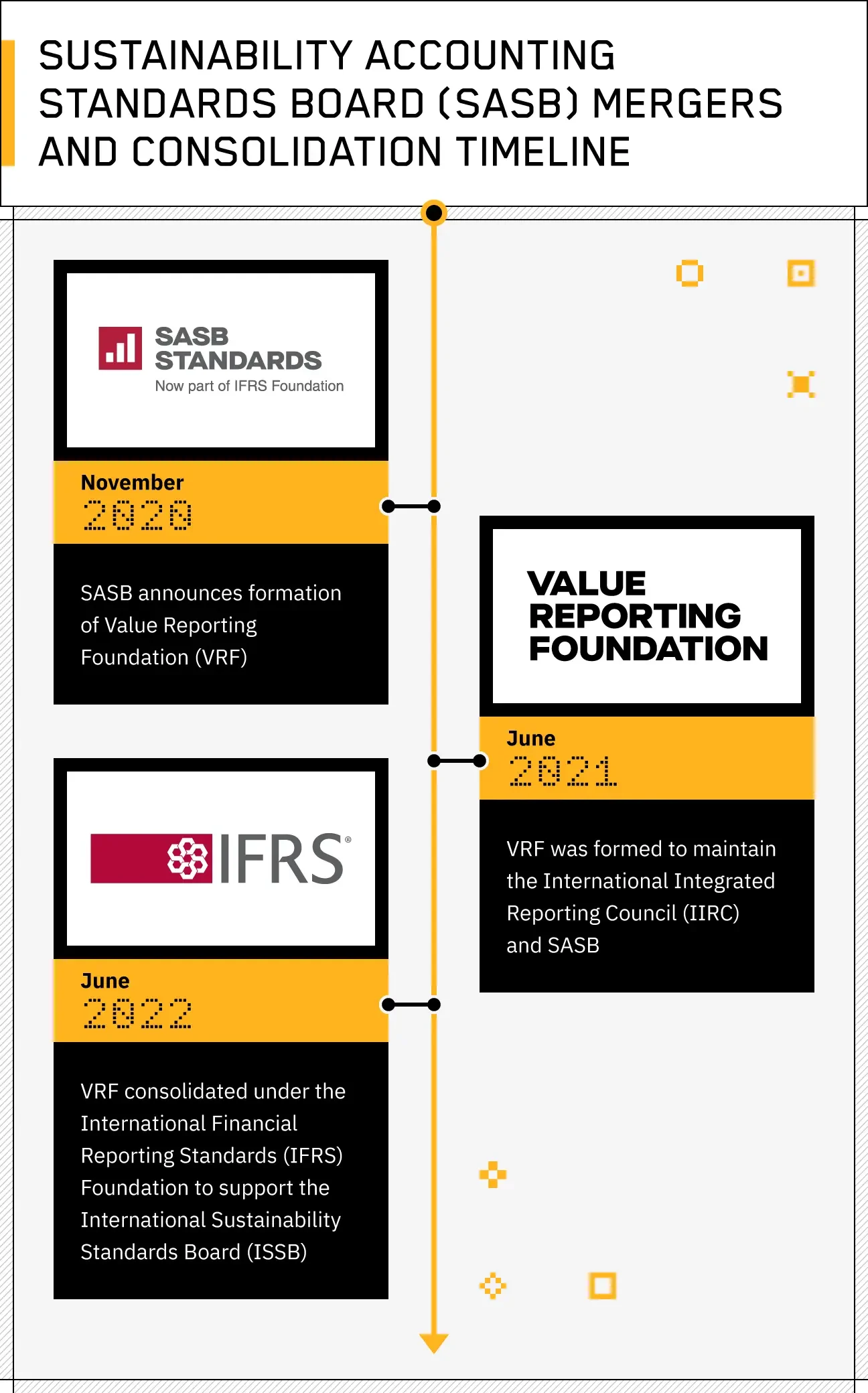The Sustainability Accounting Standards Board (SASB)’s Standards enable organizations to disclose financially material sustainability information to investors and stakeholders.
ESG issues cover a broad swath of issues. The sustainability issues relevant in one industry are not necessarily important in another industry. SASB helped by establishing 77 industry-specific guides to identify the ESG issues most likely to be financially material within those industries.
Understanding initiatives like SASB Standards can help companies create useful and relevant disclosures to improve transparency, build trust, and illustrate a business’s risks and mitigation plans with quantitative data rather than loose “green” promises. It’s especially crucial given the rise of carbon disclosure mandates and investor disclosure requests.
To help businesses navigate these standards, our guide goes over the basics businesses should know to get started with SASB’s Standards. You can find more in-depth information on SASB’s official site.
What Is SASB?
The SASB is a not-for-profit organization formed to create industry-based standards that help companies identify and disclose financially material sustainability information.
SASB’s standards identify which ESG standards are relevant to 77 industries. SASB defines “sustainability” as corporate activities that amplify or sustain a company’s capacity to create shareholder value in the long term.
The Financial Accounting Standards Board (FASB) and International Accounting Standards Board (IASB) have long been responsible for creating financial accounting and reporting standards. SASB aims to specifically create standards to help companies manage and disclose sustainability information that impacts a company’s enterprise value.
Blackstone’s Global Head of ESG Jean Rogers, Ph.D., Persefoni Sustainability Advisory Board Co-Chair Robert Eccles (Chairman, 2011-2014), and others started SASB in 2011. It was established to mirror the FASB’s and other financial standards to align with SASB’s goals.
The SASB Standards have evolved over the years to reflect the growing number of sustainability issues impacting companies.
SASB’s original Conceptual Framework gives an overview of SASB’s objectives, principles, and more. This was under review before the Value Reporting Foundation's (VRF) consolidation with the International Financial Reporting Standards (IFRS) Foundation, as discussed below.
SASB’s Evolution: Mergers and Consolidation
Investors and companies over the years began calling for a simplification of sustainability disclosures to alleviate the complexity of using multiple frameworks and standards.
SASB announced in November 2020 its merger with the International Integrated Reporting Council (IIRC), which resulted in the formation of the Value Reporting Foundation (VRF) in June 2021.
In August 2022, the IFRS Foundation assumed responsibility for SASB Standards upon its merger with the VRF The IFRS Foundation’s newly formed International Sustainability Standards Board (ISSB) has announced its intention to build on the SASB standards, and the Task Force on Climate-Related Financial Disclosure (TCFD in its standard- setting process. Its goal is to further the integration, simplification, and adoption of SASB Standards and build on SASB’s industry-based approach.

What Are the SASB Standards?
SASB Standards are tailored to 77 industries and identify the most significant ESG issues for each.
SASB focuses on industry-specific metrics rather than broad industry-agnostic disclosure standards since some sustainability issues are more relevant to some industries than others. For example, SASB sees energy management as a relevant issue to companies in the Real Estate industry, but not as much for those in the Toys & Sporting Goods industry. SASB aligned their industries with their Sustainable Industry Classification System® (SICS®).
SASB has historically provided companies with some flexibility to adapt the standards to best meet their sustainability reporting needs. However, SASB standards are set to be incorporated into the ISSB standards. For jurisdictions that adopt ISSB standards into their regulatory requirements, the discretionary aspect will change.
Companies can start using SASB’s standards by finding the standards for their industry (or industries) and reviewing guidance, case studies, disclosures from similar industries, and other resources to understand the process.
SASB’s Standards include the following:
- Disclosure topics that cover industry-specific material sustainability issues . The standards cover how handling different facets of each topic can impact a company’s capacity to create value in the long term. There is an average of six disclosure topics for each industry.
- Accounting metrics in each standard include quantitative and (sometimes) qualitative metrics. These metrics help companies measure their performance with each disclosure topic. There is an average of 13 accounting metrics for each industry.
- Technical protocols give companies guidance with areas like definitions and scope to ensure metrics are comparable between companies. These technical protocols can also provide guidance for independent third-party reviewers.
- Activity metrics quantify the scale of the issuer’s business. For example, the number of students enrolled is an activity metric for the education industry. These metrics provide additional context for the analysis of related disclosures.

How Do They Set Their Standards?
SASB developed the standards while working with experts, companies, and investors. SASB also used evidence-based research and had oversight from a standards board independent of SASB’s board of directors. It is also worth noting the importance of the public consultation due process SASB applies to its standards development.
The technical staff for SASB’s standard-setting process does the following activities to inform the SASB Standards Board’s decisions for new or amended standards:
- Monitoring industries and issues: Technical staff develops investigative research projects to help the SASB Standards Board decide if it should start a standard-setting project.
- Exposure draft development: Technical staff engages in research- and consultation-related activities, including consulting SASB Standards Advisory Group.
- Public comment period: The SASB Standards Board collects comments from experts, investors, and companies to inform voting on proposed amended or new standards.
- Public comment analysis: Technical staff creates summaries of public comments received along with related research to provide to the SASB Standards Board during voting.
- Post-implementation review: Technical staff and the SASB Standards Board assess the use and implementation of a new or amended standard.
The standards may change over time as industries change and as companies provide feedback.
Who Should Use SASB’s Standards?
Companies, investors, rating agencies, and other entities can use SASB’s standards for a variety of commercial and non-commercial uses — from disclosure guidance to evaluating companies. Below are a few examples of entities and how each can use SASB’s standards.
- Companies can use SASB’s standards for guidance on creating financially material and decision-useful disclosures for investors.
- Rating agencies can use the standards to inform company evaluations.
- Investors can use SASB Standards in policy documents.
- Reporting solutions companies can incorporate these standards into their software.
- Other vendors can integrate SASB Standards or significant parts of the Materiality Map into products or services.
Are These Standards Free?
The SASB Standards and the Materiality Finder are free for non-commercial use. However, you’ll need a commercial license to use the Materiality Map for commercial purposes.
What Is the SASB Materiality Map?
The SASB Materiality Map visualizes how 26 total sustainability topics are likely to be material for 77 industries.
SASB created the Materiality Map to help industries quickly discover what is material to their sector. It also helps organizations understand what they should measure to ensure their sustainability disclosures are in line with their financial prospects.
The Materiality Map is only accessible through a login for users of the SASB Standards Navigator. Those users are mainly organizations who license SASB Standards.
Previously, SASB found that those using the Materiality Map were using it for commercial purposes without a commercial license. The new login system prevents this misuse. However, SASB provides this screenshot for use in publications.
What Is the SASB Materiality Finder?
The SASB Materiality Finder is a tool that helps users quickly find relevant SASB disclosure topics and compare companies or industries. This tool lets users compare up to four industries to see how their most relevant disclosure topics differ. The tools break down issues into the following categories:
- General issue category includes broad versions of the SASB Standard’s disclosure topics to allow comparison between industries and companies
- Disclosure topics are industry-specific topics that are tailored to the areas particular to each industry
Any user can access the Materiality Finder for free for any use.

How Many Companies Use SASB’s Standards?
Hundreds of companies use SASB Standards to aid with their sustainability reporting. Companies can find a full list of SASB reporting companies online along with reports for each. The list allows filtering by industry, sector, country, and more. This tool is helpful for finding examples of disclosures from similar companies.
Are These Standards Mandatory?
SASB Standards are not mandatory, but some jurisdictions recommend using these standards for mandatory reporting. For example, the European Commission includes SASB among other recommended frameworks. It is also becoming increasingly common to find cases where they become “mandatory” at the request of investors. In the US, SASB is one of the most common frameworks investors will demand, along with the TCFD.
As the current SASB standards could be adopted into the ISSB, and in turn if the ISSB standards are used under any jurisdictions sustainability disclosure legislation, they could become mandatory.
How Does SASB Compare To Other ESG Frameworks and Initiatives?
SASB Standards focus only on sustainability issues that are financially material. Some sustainability reporting frameworks and standards focus on collecting sustainability information, like the GHG Protocol which focuses primarily on GHG emissions inventories. This is a great first step for ESG reporting, but those types of frameworks aren’t created to compare a company’s carbon footprint with its financial value.
Financial standards, like FASB’s accounting standards, aren’t currently set up to measure the financial materiality of sustainability topics. SASB Standards fill in this gap by taking both sustainability topics and financial materiality into account.
Understanding SASB’s role in the overall sustainability reporting ecosystem requires an understanding of standards and frameworks. According to SASB, frameworks are broad, principle-based guidance for areas like topics to cover and how information is prepared. Standards include specific requirements on what information should be reported based on topics identified in reporting frameworks.
Most importantly, SASB, GRI, and other standards/frameworks can be complementary to each other. SASB has released guidance for using their standard with others to ensure they’re working in conjunction. We’ll go over how other similar organizations, frameworks, and initiatives work along with SASB.

GRI vs. SASB
The GRI focuses on sustainable development more holistically in relation to a company's economic, environmental, and social impacts, and its standards work in the interest of a broad range of stakeholders. This includes but isn’t limited to investors.
There is tremendous room for interpretation in the GRI materiality assessment and approach, and outcomes vary widely between companies using the GRI framework. SASB tries to remove this fluctuation and ambiguity by assigning industry-specific requirements and removing that element of interpretation on the part of the organization. It aims to align on the financial impacts of ESG, and its focus is primarily on financially material sustainability matters across 77 industries.
GRI and SASB have a complementary nature, and can help companies report to various stakeholders using both standards. SASB released a guide to help reporters using both GRI and SASB Standards.
TCFD vs. SASB
SASB is complementary to the TCFD - SASB standards and TCFD recommendations can be combined and used as tools for effective climate and sustainability-related financial disclosures. With an industry-specific approach, the SASB standards can provide the appropriate climate-related disclosure topics and associated metrics to effectively implement the TCFD recommendations.
Initiatives and organizations like the Carbon Disclosure Project (CDP) have incorporated the TCFD’s recommendations into existing guidance. SASB and the Climate Disclosure Standards Board (CDSB) worked together to create the TCFD Implementation Guide to learn how to use all three for reporting.
CDP vs. SASB
A key difference between the two frameworks is their level of scope: while CDP is more specific focusing on environmental topics, SASB standards adopt a more general approach covering several areas within ESG. Another difference is the focus that SASB has on the material aspects of an organization’s sustainability performance, while CDP focuses on capturing environmental-related data for climate-related disclosure. As with SASB, CDP’s framework also aligns with the TCFD’s recommendations.
CDSB vs. SASB
The CDSB is an international collective of environmental NGOs and businesses. Their framework helps businesses report environmental information with the same quality and stringency as financial information. The CDSB also consolidated under the IFRS Foundation in January 2022.
What Is the Fundamentals of Sustainability Accounting (FSA) Credential?
The FSA Credential teaches professionals all about financial materiality for sustainability reporting. This includes learning about the following:
Level I topics (with a focus on practices and principles)
- How sustainability impacts financial materiality
- How to communicate the financial materiality for sustainability information
Level II topics (with a focus on analysis and application)
- How industry-specific information is used for investor decisions or corporate strategies
- How to review corporate performance for sustainability
The credential is useful for professionals who work in finance, sustainability, and any other area of a company or an industry that benefits from understanding sustainability accounting.
Professionals must pass the Level I and II exams to earn the FSA Credential. To start, professionals can look over the FSA Credential program and curriculum to get familiar with the exams. Then, they can register for the test online. Fees and test dates vary.
Why Are SASB Standards Important for Companies?
SASB Standards are important because they give industry-specific guidance that other standards don’t provide. These disclosure topics help companies prioritize and communicate the financial materiality of sustainability-related issues that most couldn’t previously do.
The cohesion of SASB and other standards and frameworks under the IFRS Foundation will help improve reporting. This collaborative effort makes reporting easier by streamlining multiple standards rather than forcing reporters to get familiar with many comprehensive standards.

How Can Companies Efficiently Implement SASB Standards?
Companies can use software to simplify the disclosure process, automate the Materiality Map for their sector, and ensure their company is in line with SASB Standards. Software is a cheap, fast, and efficient way of disclosing your ESG information and calculating company carbon footprints.
Some of the necessary carbon accounting solutions focus holistically on ESG disclosures, like providing resources and a platform that cover a range of ESG-related metrics. Others solely deal with the niche and complicated process of measuring GHG emissions.
Through a SaaS model, software providers can cover all bases from an ESG data collection, management, and analysis perspective. Software with a specific focus, like one catered to environmental reporting, can be an efficient solution for a company that needs help getting ahead of environmental disclosure mandates.
Learn more about how Persefoni’s Climate Management and Accounting Platform can help your company navigate SASB and other standards when working on sustainability reporting and disclosures.





